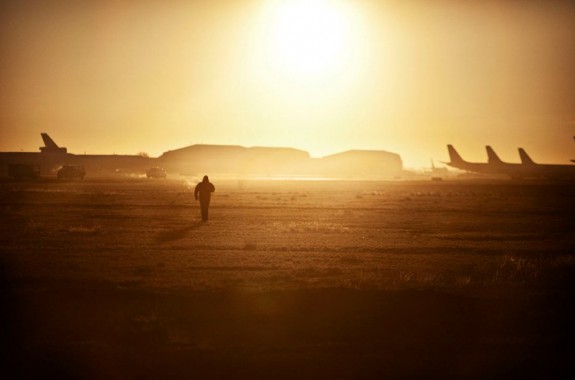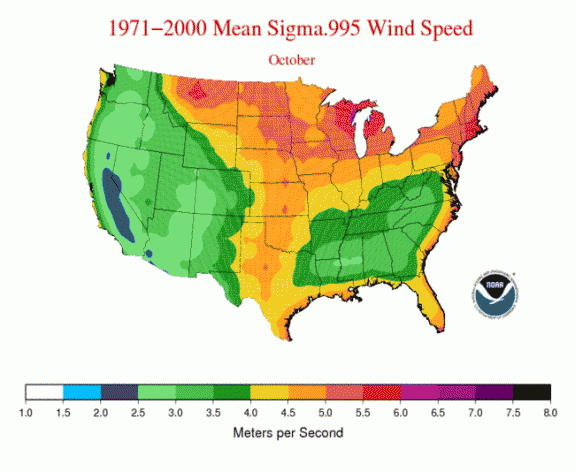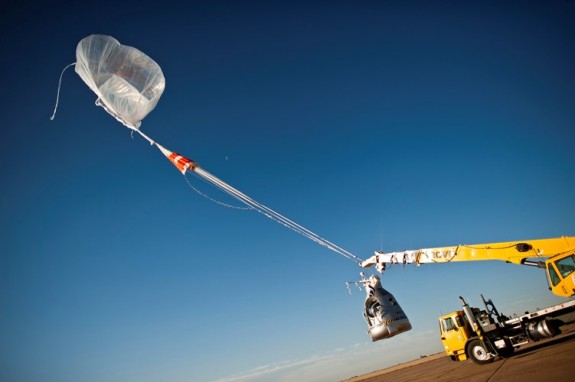What’s Up With the Winds That Keep Grounding Felix Baumgartner’s Leap From the Stratosphere?
Getting the right weather conditions to launch may be one of the hardest parts of Felix Baumgartner’s 23-mile sky dive

The New Mexico launch site for the Red Bull Stratos jump. Photo: Red Bull Stratos
From its initial target window this past Monday, the balloon launch meant to carry Felix Baumgartner aloft for his 23-mile skydive from the stratosphere has been postponed twice so far due to high winds near the launch site. In order for the launch to go ahead, says Space.com, wind speeds from the surface to around 800 feet in the air need to be no more than two miles per hour (or just under one meter per second). Getting the right conditions for the launch, it seems, may be one of the most challenging parts of the whole endeavor. Here’s why:
New Mexico Winds Are Almost Never That Low
Wind records for the entire United States, collected by the National Oceanic and Atmospheric Administration and spanning from 1930 to 1996, show that during October the winds in New Mexico don’t get below three miles per hour on average.
As you can see on this map, put together with a separate set of information, southeastern New Mexico may be on the low end of wind speeds, but the average from 1971 to 2000 is still in the three to 4.5 meter per second range.

Average October wind speeds over the continental US. Photo: NOAA
Within this multi-year average, of course, there will certainly be peaks and dips. The wind speed is controlled by a number of factors, ranging from seasonal cycles, to daily cycles, to transient atmospheric conditions that can persist for days to weeks.
Fall is a Weird Time for New Mexican Winds
The fall months are also a period of transition for southwestern weather, according to Phillip Shumaker, an operational weather forecaster who is responsible for forecasting the weather conditions for California, Arizona, New Mexico and western Texas. During the summer and through the beginning of September, the region is dominated by the North American monsoon, a massive weather system that brings warm, wet air up from the Gulf of Mexico. Right around now, Shumaker told SmartNews, “the state is transitioning to more synoptic frontal patterns.” That is, rather than the winds being driven by a big weather pattern like the monsoon, they are instead going to be jostled around a bit more by synoptic scale (around 1000 kilometers wide) cold and warm fronts.
Right Now, Specifically, Is Extra Weird
Hanging over New Mexico this week, says Shumaker, are two separate and very different air masses. To the west, he says, the winds are continental tropical: hot and dry. To the east, the air is continental polar: cold and dry. Having a pocket of warm and a pocket of cold air in close proximity is a recipe for stronger wind speeds.
Getting Prolonged Calm Winds Requires a Very Special Set of Circumstances

Baumgartner’s fragile balloon can’t handle a lot of jostling from gusting winds. Photo: Red Bull Stratos
“The best situation they can hope for will be high pressure building into the state after the passage of a cold front,” says Shumaker.
For Baumgartner to get the best shot at success, he said, “you want a weak pressure gradient, high pressure centered over the region, weak temperature gradients, absence of competing air masses, weak low level moisture,” and no strands of the jet stream hanging overhead to muddy up the high-altitude winds.
On top of it all, wind patterns have a tendency to change around throughout the course of the day. “The best time , in my opinion,” says Shumaker, “would be to jump mid-morning” after the overnight winds die down, but before the peak mid-afternoon winds kick up.
But Surface Winds Aren’t The Only Thing To Watch
Baumgartner has been floored by gusts of wind coming along and threatening his massive yet fragile balloon. According to the Red Bull Stratos website, however, wind is just one of many worries. They also won’t be able to launch if it’s raining or if it’s cloudy. Their concern encompasses more than just planetary weather, even. The Stratos team is watching for activity from the Sun and will shutter the launch in the event of a solar flare or other inclimate space weather.
The next potential window for Baumgartner’s launch is Sunday, October 14.
More from Smithsonian.com:
Skydiver Plans to Break the Sound Barrier by Jumping From 120,000 Feet
/https://tf-cmsv2-smithsonianmag-media.s3.amazonaws.com/accounts/headshot/smartnews-colin-schultz-240.jpg)
/https://tf-cmsv2-smithsonianmag-media.s3.amazonaws.com/accounts/headshot/smartnews-colin-schultz-240.jpg)